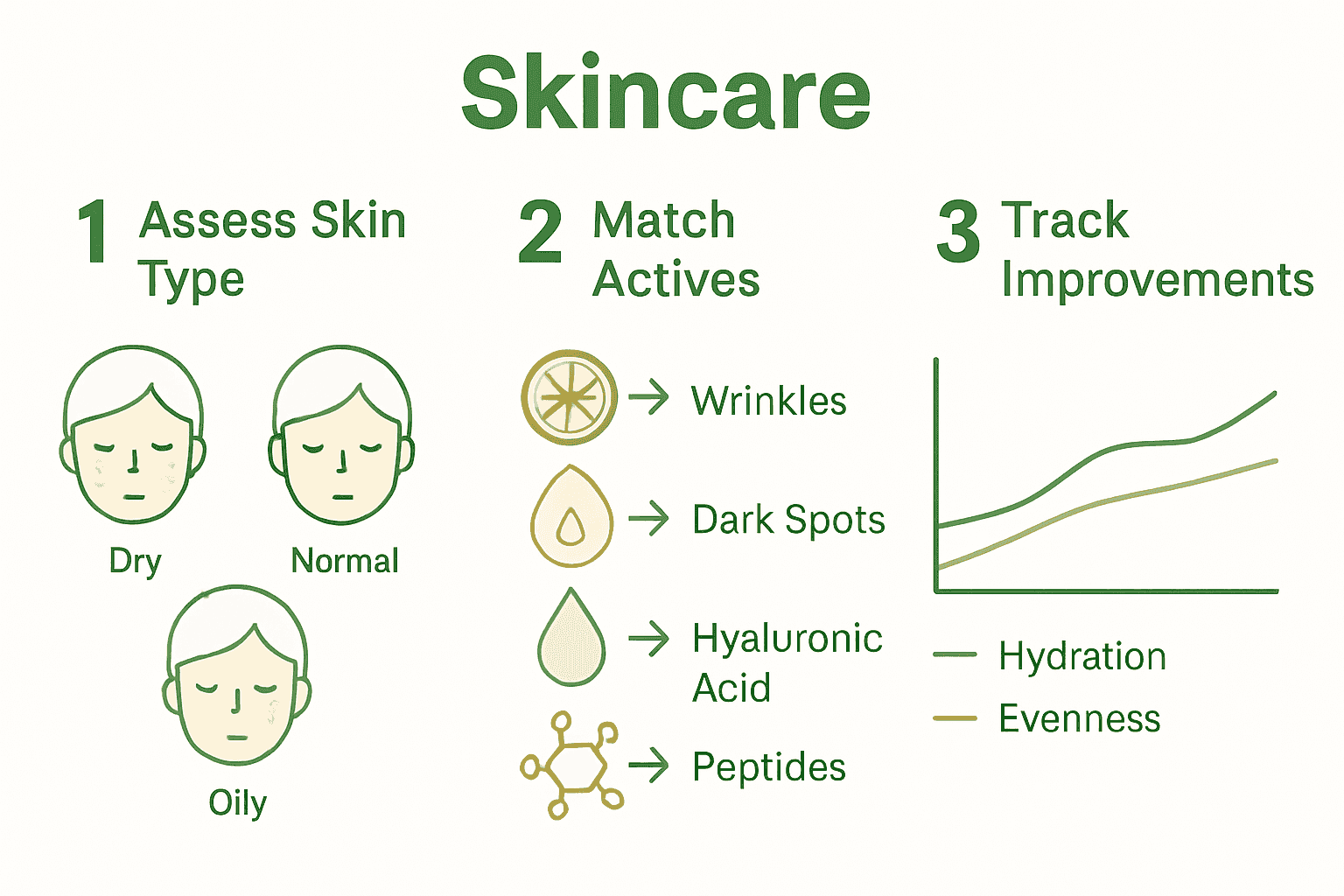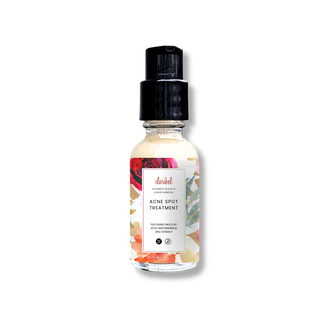Over 60 percent of people use skincare products that do not match their real skin type and concerns. The right regimen can make a dramatic difference in how healthy and vibrant your skin looks. Learning how to assess your skin, choose ingredients wisely, and adapt your routine over time sets you up for long-term results and a glowing complexion at any age.
Table of Contents
- Step 1: Assess Your Skin Type And Needs
- Step 2: Identify Essential Active Ingredients
- Step 3: Select Clean Vegan Skincare Products
- Step 4: Apply Actives For Optimal Results
- Step 5: Verify Improvements And Adjust Routine
Quick Summary
| Key Point | Explanation |
|---|---|
| 1. Identify Your Skin Type | Understanding your skin type helps you choose products that cater to its specific needs effectively. |
| 2. Learn Active Ingredients | Familiarize yourself with key active ingredients to target your skin concerns for better results. |
| 3. Choose Clean Vegan Products | Opt for products with plant-based ingredients that are ethical and safe for your skin and the environment. |
| 4. Apply Actives Properly | Use active ingredients in the correct order and concentration to enhance their effectiveness on your skin. |
| 5. Track Your Skin’s Progress | Document your skincare routine and results to adjust products as needed for optimal skin health. |
Step 1: Assess Your Skin Type and Needs
Understanding your unique skin type is the foundation for creating an effective skincare routine. By accurately identifying your skin characteristics, you can select targeted products that address your specific concerns and promote optimal skin health.
According to siumed.org, skin types generally fall into five categories: oily, dry, normal, combination, and sensitive. To determine your skin type, start with a simple at-home assessment. After cleansing your face, wait one hour without applying any products. Then observe how your skin feels and looks.
- Oily Skin: Appears shiny with visible oil across cheeks, forehead, and nose
- Dry Skin: Feels tight, rough, or flaky with potential visible dry patches
- Combination Skin: Oily in the T-zone (forehead, nose, chin) while remaining normal or dry in other areas
- Sensitive Skin: Prone to redness, irritation, or quick reactivity to new products
- Normal Skin: Balanced texture without excess oil or significant dryness
As recommended by greenandnatural.org, avoid making common skincare mistakes by tailoring your routine to your specific skin type. This means selecting cleansers, moisturizers, and treatments that match your skin’s unique needs. For instance, those with oily skin might benefit from lightweight, oil-free products, while individuals with dry skin should opt for richer, more hydrating formulations.
Remember that skin type can change with factors like age, hormones, climate, and lifestyle. Regularly reassess your skin’s condition and be prepared to adjust your skincare approach accordingly. Your skin is dynamic and requires adaptable care.
Step 2: Identify Essential Active Ingredients
Navigating the world of skincare ingredients can feel overwhelming, but understanding key active ingredients is crucial for developing an effective skincare routine. By learning which ingredients target specific skin concerns, you can make informed decisions about the products you choose.
According to health.clevelandclinic.org, several powerhouse ingredients stand out for their remarkable skin benefits. Retinol tops the list for addressing multiple concerns like acne and wrinkles. It works by accelerating cell turnover and stimulating collagen production. Vitamin C (L-ascorbic acid) is another superstar ingredient that helps synthesize collagen and reduce fine lines while providing antioxidant protection.
Dermatologists recommend specific ingredients for different skin needs. nm.org highlights mineral sunscreens as essential for UV protection and wrinkle prevention. Additional key active ingredients include:
- Hyaluronic Acid: Provides intense hydration and improves skin elasticity
- Retinoids: Effective for treating wrinkles, acne, and dark spots
- Niacinamide: Helps balance oil production and minimize pore appearance
- Peptides: Supports collagen production and skin repair
When exploring active ingredients, remember that not all ingredients work the same for everyone. Start with patch tests and introduce new products gradually. This approach allows you to monitor how your skin responds and minimize potential irritation.

Check out our guide on natural skin care ingredients to discover more about clean and effective skincare solutions tailored to your unique skin needs.
Step 3: Select Clean Vegan Skincare Products
Choosing clean vegan skincare products is more than a trend its a commitment to your skin and the environment. This step will help you navigate the world of ethical skincare by understanding what makes a product truly clean and vegan.
According to elementalplanet.org, clean vegan skincare focuses on plant-based ingredients that deliver powerful results. Look for products containing natural components like shea butter, essential oils, and hydrosols. These ingredients not only nourish your skin but also align with ethical and sustainable beauty practices.
When selecting vegan skincare, consider these key criteria:
- Ingredient Transparency: Check for clear labeling of all ingredients
- Cruelty Free Certification: Ensure no animal testing was involved
- Plant Based Formulations: Prioritize natural botanical extracts
- No Animal Derived Ingredients: Avoid components like lanolin, beeswax, or collagen
Cosmeticassociation.org highlights the importance of understanding active ingredients in your skincare. Focus on scientifically backed plant-derived ingredients like vitamin C, hyaluronic acid, and natural retinol alternatives that provide genuine skin benefits.
Learn more about creating your perfect vegan skincare routine in our vegan skincare staples guide. Each product you choose is a step towards healthier skin and a more sustainable beauty approach.

Step 4: Apply Actives for Optimal Results
Applying active skincare ingredients requires precision and strategy to unlock their full potential. Understanding the correct application methods can dramatically enhance your skincare routine and help you achieve the best possible results.
According to verified.org, the concentration and application of active ingredients like L-ascorbic acid (vitamin C) play a crucial role in their effectiveness. Start by introducing active ingredients gradually into your routine. Begin with lower concentrations and less frequent applications to allow your skin to build tolerance.
Key guidelines for applying active ingredients include:
- Layer from thinnest to thickest consistency
- Apply active ingredients directly to clean skin
- Wait 1-2 minutes between different product applications
- Use sunscreen during the day when using photosensitive ingredients
nm.org recommends specific application strategies for ingredients like retinoids and mineral sunscreens. For retinoids start with a small amount two to three times a week and gradually increase frequency. Always apply mineral sunscreens as the final step in your morning skincare routine to ensure maximum protection.
Pro tip: Patch test new active ingredients on a small area of skin and monitor for any adverse reactions.
Some ingredients like vitamin C work best in the morning, while retinoids are typically recommended for nighttime use.
Check out our guide on face serum application timing to further refine your skincare approach and maximize the benefits of your active ingredients.
Step 5: Verify Improvements and Adjust Routine
Tracking your skincare progress is crucial for developing an effective long-term routine that truly works for your unique skin. This step helps you become your own skin health detective, understanding how different ingredients and practices impact your complexion.
According to siumed.org, consulting with a professional can provide valuable insights into your skin’s changing needs. However, you can also conduct a personal assessment by carefully documenting your skin’s response to new products and ingredients.
Effective tracking methods include:
- Take weekly progress photos in consistent lighting
- Maintain a skincare journal noting product usage and skin reactions
- Track specific concerns like hydration, breakouts, or texture changes
- Monitor skin sensitivity and any potential irritation
greenandnatural.org recommends being attentive to how your skin responds to different approaches. Not all products work identically for everyone. Watch for signs of improvement such as increased hydration, reduced inflammation, more even skin tone, or decreased breakouts.
Pro tip: Give new skincare routines at least 4-6 weeks before making significant changes. Skin cell turnover takes time, and patience is key to seeing genuine results. If you notice persistent issues or no improvements, consider consulting a dermatologist for personalized guidance.
Ready to dive deeper into understanding your skin’s unique journey? Check out our guide on natural skin care ingredients for more insights into creating a personalized skincare approach.
Unlock the Power of Active Ingredients for Healthy Skin
Struggling to find skincare products that truly deliver on the promise of active ingredients without the risks of fillers or harsh chemicals The “Complete Guide to Active Skincare Ingredients for Women” helps you navigate which ingredients really support your skin goals like hydration collagen support and gentle care for sensitive skin. Whether you want to boost your glow with vitamin C or firm your complexion with peptides it is crucial to choose clean formulas designed for your unique skin type and concerns.
Discover our carefully crafted selection from Vitamin C Benefits for Skin | A Top Powerful Antioxidant to Peptides for Skin Care: Fight the Signs of Aging and Natural Products for Sensitive Skin crafted to empower your skincare routine with effective and safe ingredients.

Now is the time to upgrade your skincare routine with our clean vegan and cruelty free solutions that ship free in the US Feel confident you are treating your skin with the very best Visit ClaribelSkincare.com and start your journey to radiant skin today.
Frequently Asked Questions
How do I determine which active skincare ingredients my skin needs?
To determine the right active ingredients for your skin, first assess your skin type and specific concerns, such as acne or dryness. Start by introducing one new active ingredient at a time and monitor your skin’s response over 4-6 weeks to evaluate its effectiveness.
What is the correct order for applying active skincare ingredients?
Apply active ingredients starting from the thinnest to the thickest consistency. For example, use liquid serums before creams to ensure the product penetrates the skin properly.
How often should I use active ingredients like retinol or vitamin C?
Start by using retinol or vitamin C a few times per week, gradually increasing the frequency as your skin builds tolerance. If using vitamin C in the morning, apply it daily for optimal results while maintaining consistent use of retinol at night.
What should I do if my skin reacts negatively to an active ingredient?
If you notice irritation or a negative reaction, stop using the ingredient immediately. Consider patch testing on a small area of skin and wait for 24-48 hours before reintroducing it, potentially at a lower concentration or frequency.
Can I mix different active ingredients in my skincare routine?
Yes, but be cautious about mixing certain active ingredients, like retinol and vitamin C, as they can cause irritation. Introduce them separately in your routine—retinol at night and vitamin C in the morning—for optimal effects with minimal risk of irritation.
How do I track the effectiveness of my active skincare products?
To track effectiveness, maintain a skincare journal documenting product use and skin changes over time. Take weekly photos and note improvements or negative reactions to better understand the impact of each active ingredient.



